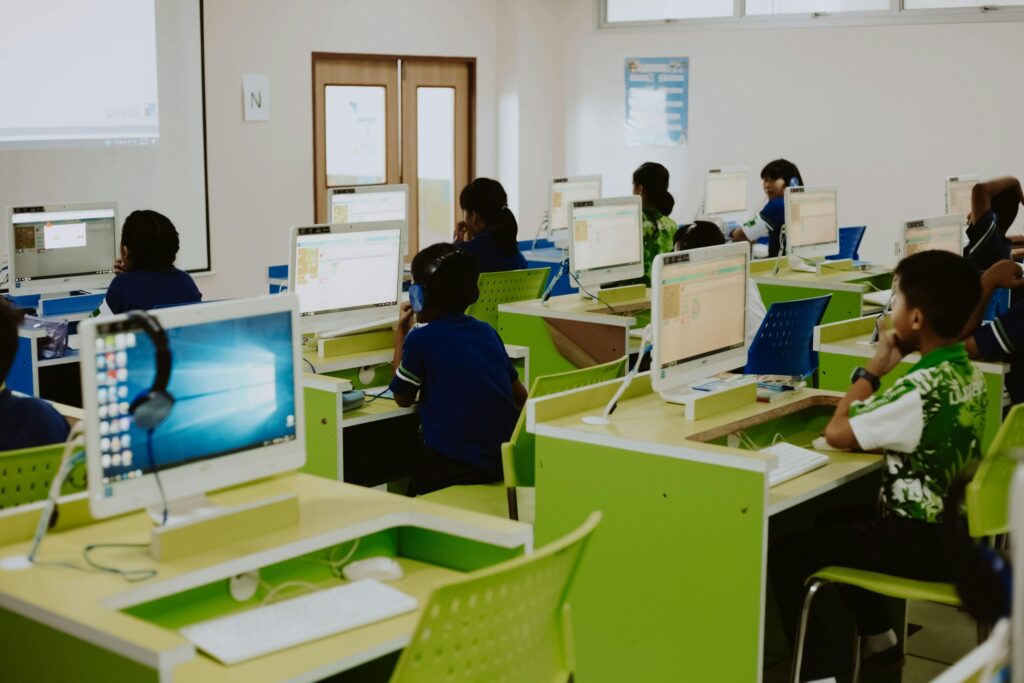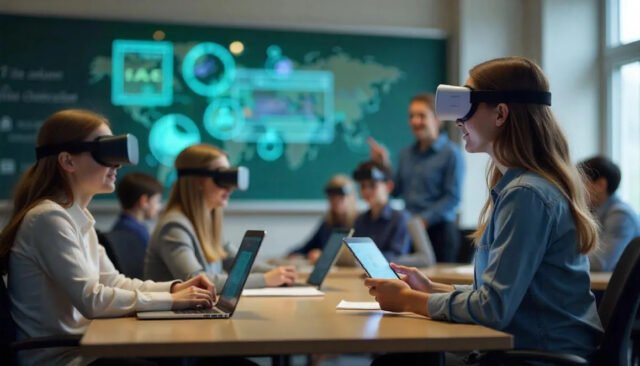In 2025, AI is changing the way virtual classrooms work—no longer a futuristic concept, but a core driver of today’s learning environments. From automating repetitive tasks to creating immersive, adaptive lessons, its impact is reshaping education at every level. Having followed this shift closely in both tech and education spaces, I’ll walk you through the key innovations, real-world effects, and where we’re headed next.
A New Era of Personalised Learning
The one-size-fits-all model of education is rapidly fading. Today, AI-powered platforms analyse real-time data on individual students—their quiz scores, reading patterns, even engagement signals—to craft highly personalised learning paths. These systems adapt continuously, modifying difficulty levels, suggesting revisions, and providing targeted exercises tailored to each learner’s needs.
Schools using these technologies report startling results: higher engagement, reduced dropout rates, and richer learning outcomes across the board. It’s not just theory—some systems powered by generative AI have slashed study time by nearly 30% in university distance learning programs.

Real-Time Feedback and Intelligence-Driven Analytics
Gone are the days of delayed assessments and long waits for feedback. AI now offers instant evaluation, scoring essays, analysing code, and grading complex assignments within seconds. These rapid cycles allow students to correct errors on the spot and internalise lessons more effectively, while instructors gain powerful dashboards highlighting class-wide strengths and areas for improvement.
In higher education, tools like Panopto’s AI-powered video indexing let students search lecture recordings by keyword, instantly accessing precisely the material they need. These analytics aren’t just useful—they’re revolutionising how instructors teach and how institutions evaluate learning outcomes.
AI Tutors: Learning Assistance, 24/7
Imagine having a tutor available at any hour, ready to explain algebra, assist with coding, or discuss Shakespeare. AI-driven chatbots and tutor systems make that possible. These intelligent tutors remember previous student interactions, adapt explanations accordingly, and stay tirelessly available outside school hours.
Their scope is expanding: platforms such as Khanmigo, Socratic, and others are gaining traction in virtual classrooms, providing sophisticated one-on-one guidance when teachers can’t be present. While they don’t replace mentors, these AI tools free human educators to focus on deeper engagement with critical thinking and emotional support.
Immersive Virtual and Augmented Reality Classrooms
2025 sees virtual classrooms becoming spaces of experience, not just instruction. AI is powering VR and AR environments that allow students to journey through ancient civilisations, explore the human body in 3D, or run simulated labs from home.
These experiences aren’t static—they respond to learners. AI avatars adapt explanations, change the pace, and present interactive challenges based on individual performance. The result? Learning that feels dynamic, engaging, and powerful in ways that textbooks cannot match.
Content Creation at Scale: Teachers’ AI Assistants
Generating lesson plans, quizzes, and teaching materials is time-consuming. In 2025, teachers are collaborating with AI tools that draft slide decks, quiz banks, and interactive worksheets tailored to learning objectives.
From Elai.io and Synthesia producing video lessons to Khanmigo and Curipod generating quizzes, the content pipeline has been turbocharged. Educators can now spend more time mentoring and less time on repetitive tasks—a shift toward human-centric teaching that’s grounded in creativity, not chaos.
Embracing Multilingual, Inclusive Classrooms
The modern classroom is global, and AI is ensuring no student is left behind. Real-time translation systems provide subtitles and chat translations, erasing language barriers and enabling diverse classrooms.
Simultaneously, AI-driven assistive tools—such as text-to-speech, real-time transcription, and adaptive interfaces—empower students with different abilities. In regions like Kerala, India, virtual AI initiatives are explicitly designed to support inclusive practice in public education systems.
Ethical Use, Privacy, and the Human Touch
As AI takes a central stage, questions arise around privacy, cheating, and cognitive offloading—that is, students relying too heavily on AI and neglecting critical thinking.
Educators and policymakers are responding. U.S. states and institutions are rolling out guidelines and training programs to ensure responsible AI use, while analytics tools track misuse in real time. Experts emphasise the importance of maintaining human oversight, ensuring AI remains an assistant, not a replacement.
The Business and Policy Landscape
On the global stage—from India’s vice-chancellors to US federal initiatives—there’s a consensus: AI must be integrated responsibly into education. Public–private partnerships, federal funding, and competitive grants are accelerating the development of AI literacy and platforms for diverse learners.
Business schools have embraced AI wholeheartedly: systems like All Day TA have fielded thousands of student queries, and now hundreds of institutions worldwide are following suit. Meanwhile, companies like Duolingo are creating AI conversation tools for languages and beyond, with broader goals to scale learning across subjects like math and music.
Human-Centred AI: The Path Forward
Will.i.am, Cannes discussions, and global academia all share a common thread: data privacy and ethical use must underpin AI’s future in education. AI should be a creative ally, not a shortcut, reinforcing student autonomy rather than supplanting it.
Educators emphasise the need for emotional intelligence, critical thinking, and algorithmic transparency. They know that AI’s job is not to obscure human nuance but to spotlight it, elevating teachers to mentors in a data-rich world.
The Emotional and Intellectual Promise of AI-Driven Classrooms
AI is more than a tool—it’s reshaping how we perceive teaching and learning. Virtual classrooms powered by AI will be:
- Emotionally intelligent: Adaptive systems that sense stress or confusion and respond empathetically, tailoring pacing and encouragement.
- Creatively expansive: Virtual labs, historical simulations, and interactive storytelling deepen understanding and spark curiosity.
- Inclusive by design: Multilingual tools, accessibility features, and context-aware platforms make equitable education possible worldwide.
- Human-centric: Automated grading and content generation free teachers to focus on socio-emotional learning, mentorship, and complex problem-solving.
Challenges and Considerations
AI’s progress comes with caveats:
- Digital divide: Not all schools have access to the necessary technology—some regions still lack basic infrastructure.
- Ethical concerns: Data privacy, bias in AI algorithms, and overreliance are real risks. Governance must be robust.
- Teacher training: Only about half of educators feel prepared to integrate AI effectively.
- Maintaining rigour: While AI grades well, thoughtful human feedback—especially in arts and critical disciplines—remains indispensable.

What’s Next: The Future of Virtual Classrooms
The AI-driven classrooms of 2025 are powerful—but this is just the beginning. Future directions include:
- Emotion-detecting AI tutors: Agents that monitor tone, facial expression, and engagement to adjust their support.
- Seamless AR/VR integration: Non-wearable mixed-reality experiences embedded in everyday learning.
- Micro-credential portfolios: Student portfolios showcasing AI-validated mastery, recognised by employers worldwide.
- Continuous learning ecosystems: Platforms that blend academic, vocational, and lifelong learning, all tailored by AI.
Conclusion:
AI in 2025 isn’t a distant hypothesis—it’s a lived reality in virtual classrooms worldwide. It’s personalising education, accelerating feedback, creating immersive learning, assisting teachers, and making schools more inclusive. At the same time, educators and policymakers are consciously shaping this transformation to preserve human insight, ethical standards, and fairness.
As schools evolve, the question becomes not whether AI belongs in the classroom, but how we shape it to nurture better thinkers, collaborators, and citizens. When guided by ethical frameworks, powerful tools, and skilled mentors, AI will help us reimagine education, not replace it.
Join Our Social Media Channels:
WhatsApp: NaijaEyes
Facebook: NaijaEyes
Twitter: NaijaEyes
Instagram: NaijaEyes
TikTok: NaijaEyes
READ THE LATEST EDUCATION NEWS





